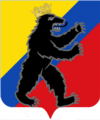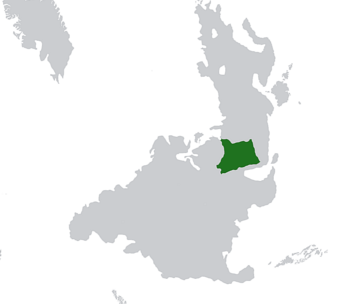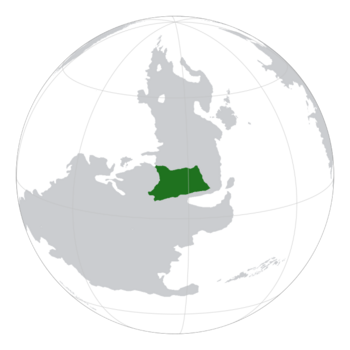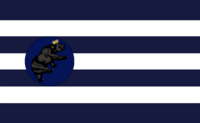Akvarelusus
Grand Duchy of Akvarelusus Velikoye knyazhestvo iz Akvarelusus | |
|---|---|
Motto: "Dulce et decorum est pro patria mori" "It is sweet and proper to die for one's country" | |
Akvarelian position in the continent of Ostlandet | |
| Capital and largest city | Ivory Tower |
| Official languages | Akvarelian Slavic |
| Ethnic groups (2022) |
|
| Religion (2022) |
|
| Demonym(s) | Akvarelian |
| Government | Federal parliamentary constitutional monarchy |
| Konrad XVI iz Elusus | |
| Asmik Fyodorovich | |
| Legislature | Bicameral |
| Senat | |
| Chamber of Representatives | |
| Establishment | |
| 3.8 billion B.C.-11.700 B.C. | |
| 375-387 A.D. | |
| (459 A.D.- 1696) | |
| (1696-1743) | |
| (1740-1743) | |
| (1744-1919) | |
| (1919-1929) | |
• Grand Duchy of Akvarelusus | (1929-present) |
| Population | |
• 2022 census | |
| GDP (nominal) | 2022 estimate |
• Total | |
• Per capita | |
| Gini (2022) | low |
| HDI (2022) | high |
| Currency | Kazé (Ké) (KZE) |
| Time zone | AMT+12 |
| Date format | DD-MM-YYYY |
| Driving side | left |
| Calling code | +401 |
| Internet TLD | .ak |
Akvarelusus, officially known as: Grand Duchy of Akvarelusus (Akvarelian Slavic: Velikoye knyazhestvo iz Akvarelusus) is located in the center on the continent of Ostlandet with the Acernis Ocean to its west and Kaosueh Mountains (Akvarelian Slavic: Altan Gory) Akvarelusus borders two nations in total: Baltanla to its south and Monsilva to its southeast. The capital Ivory Tower is located in the Elician Plains and is also its biggest city. Akvarelusus is a federal parliamentary constitutional monarchy. It is currently ruled by Grand Duke Konrad XVI iz Elusus who became duke after his fathers stepped down from the position in 1998. The nation animal is the Black Bear which can be found in the foresters of western Akvarelusus.
Contents
- 1 Etymology
- 2 History
- 2.1 Prehistory (3.8 billion B.C.-11.700 B.C)
- 2.2 Great Migration (375-387 A.D.)
- 2.3 The Duchy of Akvar (459 A.D.- 1696)
- 2.4 Baltanian rule (1696-1743)
- 2.5 War of Independence (1740-1743)
- 2.6 Grand Duchy of Akvar (1744-1919)
- 2.7 Thirty Year War (1919-1939)
- 2.8 Grand Duchy of Akvarelusus (1939-present)
- 3 Geography
- 4 Government
- 5 Economy
- 6 Demographics
- 7 Culture
Etymology
The name Akvarelusus is formed from two terms: Akvar which origians are unknown and the second part Elusus which is the house of the current Grand Duke. The second part Elusus was added after the Thirty Year war.
History
Prehistory (3.8 billion B.C.-11.700 B.C)
The land on which Akvarelusus now belongs to was nearly all the time the seafloor of the ancient sea of Letik because of this Akvarelusus has the biggest marine-fossil record in whole Terraconserva. The oldest known fossil of Terraconserva (Cyanobacteria) was found in the Kaosueh Mountains.
Great Migration (375-387 A.D.)
There is little to no evidence for human activity before this event. The Great Migration describes the event where the Akvarelian people migrated from the south of Ostlandet into the Elician Plains. Currently the scientific community can not agree on a reason why this migration took place. The Proto-Akvarelians quickly established themselves with founding numerus villages. One of the most dominant communities in this era was the village of Rekatect (Ivory Tower).
The Duchy of Akvar (459 A.D.- 1696)
After conquering all neighboring settlements, Ivory Tower became the capital of the new nation. The following decades were a time of slow economic growth that was frequently interrupted by changing dynasties for the Duchy of Akvar with this growth came also an upswing in culture. As the town of Domice became a local cultural and intellectual capital. This age of development came to the end when the ruler of Akvar, Vladislav (Slava) Georgiy, died by the hands of his own sister, who murdered him while he was drunk. The motive is widely believed to be jealousy, as she wanted the crown for her husband, who was a member of the Baltanian Imperial Family.
Baltanian rule (1696-1743)
Because of the crown passing down to the Baltanian Imperial Family, the Duchy of Akvar became a part of the Empire of Baltanla. Even though there was no violent oppression by the Baltanian Empire there was great resentment by the Akvarelian people towards the Baltanians mainly because of the differences in culture and religion. The Baltanian Empire was largely of buddhist believe and Akvarelians were traditionally christian. Eventually these and many other rather small differences in culture, religion and language led to the Akvarelian war of Independence.
War of Independence (1740-1743)
Even before 1740 there were many Akvarelian pesante uprisings but in the year 1740 the first violent clashes between the Akvarelian peasantry and the Imperial Guard started to take place. The massacre of Wysocko, in which the Imperial Guard shot at unarmed protestors, is seen as the official beginning of the Akvarelian War of Independence. After this the public in Akvar was outraged and started an open rebellion against the Empire of Baltanla. This rebellion was joined by the Akvarelian nobility after they themselves learned about the plan to confiscate their land for the Baltanian Emperor. The war effort of the Akavrelian resistance was to reinstall a Akvarelian duke as a head of state and to push the Balanian troops back to the Baltanian heartlands. The rebels were also supported by the Kingdom of Great Shan, mainly with military aid. But also many of the most experienced rebels were trained in the kingdom, allowing the rebels to fight on even terms with the Baltanian Royal Army. The goals of the rebels were reached after the Battle of the Pink Mountain, where the great grandson of Vladislav Georgiy, Barino Georgiy III, led the an army of volunteers against the Imperial Forces and scored a decisive victory with this victory he established himself as the new ruler of the Grand Duchy of Akvar.
Grand Duchy of Akvar (1744-1919)
One of the most important events happened right after the War of Independence, which was the conquering of the county of Kravoustí. This swift war established the modern day borders of Akvarelusus and making it a grand duchy. After the short conflict Akvar underwent a rapid industrialization. The cause for this change is to be contributed to the discovery of massiv quantities of iron ore, coal and other metals in the Kaosueh Mountains and the Matio Basis. With this came hand in hand a boom in population. Unable to cope with this drastic change were the southern regions of Akvar, who always were the breadbasket and economic center of the country. Furthermore new tax laws, which favored the northern regions over the southern once caused a mass population change as more and people moved into the northern cities to look for work. Those who remained in the southern regions showed ever more disfavor with the currant government and with now republics establishing themselves all over Terraconserva, a separatist republican ideology was forming in the south. Splitting off from Akvar was tried in the Thirty Year War.
Thirty Year War (1919-1939)
Although a civil war this war is often simply referred to as the Thirty year war. The war was caused by the southern regions trying to split off from Akvar. They succeeded with this in 1919 when the Confederation of Free Territories (CFT), under the leadership of Miroslav Klavic, split off from Akvar that in turn declared war on the CFT. The Duchy was also in the midst of modernizing its equipment and were further more supported by the Kingdom of Monsilva, which had great sympathy to the northern cause and were themselves afraid of a rebellion. The war which followed is considered to be the most deadly conflict in Akvarelian history, claiming over a million casualties, including the royal family, who were assassinated, as well as the leader of the CFT, who was defenestrated by Akvarelian solideres. After this brutal conflict. which ended in a Akvarelian victory, the Grand Duchy of Akvar did not have a Grand Duke. Claiming the the throne was Vlodomir I iz Elusus who was prominent war hero and a experienced leader.
Grand Duchy of Akvarelusus (1939-present)
After Vlodomir I took power he combined the names Akvar and Elusus as a symbolic gesture to symbolize the birth of a new nation. The new Grand Duke passed away just a few years into his rulership passing the crown down to his son Konrad XV iz Elusus. There was once again economic growth that however came abruptly to an end in the year 1993. What followed were mass protest and turmoil forcing the ruling Grand Duke of Ferdinand IV iz Elusus to step down and passing the crown down to his son Konrad, who through installing a new currency managed to save the nation from another civil war. On the 5th of January 2012 Akvarelusus became an interest state in the Cooperation and Development Coalition. In 2023 after extensive military spending the Akvarelian economy entered inflation that increased the cost of living dramatically. This sparked numerous anti-government protests that later devolved into riots.The riots as a consequence forced the grand duke to create a consecution and transformed Akvarelusus into a federal parliamentary constitutional monarchy. After this moves were made so that Akvarelusus could join the Ostlandet Union, which it did in September of the same year.
Geography
Akvarelusus is a nearly landlocked country with only a 70 km (41,6 mi) coast in the northwest. In the east the landscape rises to the Kaosueh Mountains in which the Matio River, which is the biggest river in the whole country, has its source. The Kaosueh Mountains are the heart of the industrial sector of Akvarelusus as they are very rich on natural resources. Furthermore in the south there is also the Puzil River that makes up the border with Monsilva. This is also the most fertile region of the whole country. The Elecian Plains are located in the center of Akvarelusus and are formed by rolling hills and large birch forests.
Climate
Akvarelusus has a mostly temperate climate. The climate is influenced by moderately warm, humid air from the Acernis Ocean. Average annual temperatures range from 5.5–7 °C (41.9–44.6 °F) in the north, to 11–13 °C (51.8–55.4 °F) in the south. Precipitation is highest in the east and south and lowest in the northwest and north. Eastern Akvarelusus, particularly in the Kaosueh Mountains, receives around 120 centimeters (47.2 in) of precipitation annually, while the coastal areas of the Acernis Ocean receive around 40 centimeters (15.7 in).
Water availability from the major river basins is expected to decrease due to climate change, especially in summer. This poses risks to the agricultural sector. The negative impacts of climate change on agriculture are mostly felt in the south of the country, which realis greatly on its agricultural section.
Environment
Akvarelusus has six national and 15 Protected Landscape areas.
Government
Akvarelusus is a federal parliamentary constitutional monarchy since 2023.
The Akvarelian Senat holds sovereignty over the nation and serves as its highest authority. The Senate is a legislative body that possesses the right of legislative initiative and, because all laws required its consent, can effectively veto any bill coming from the House of Representatives. The Senate is able to set guidelines and make organisational changes within the executive branch, act as supreme arbitrator in administrative disputes between okrugs. It is composed of representatives who are elected in every okrug from a list from its ruling political party.
The Akvarelian House of Representatives is a legislative body elected by Akvarelian citizens, which are between the ages of 18-99, that effectively serves as parliament. It has the right to propose bills and, with the concurrence of the Senate, approve the state budget annually and the military budget for periods of seven years. All laws required the House's approval to pass.
The Grand Duke is head of state of the nation – he is not a ruler. He appoints the chancellor, usually the person able to command the confidence of the House of Representatives. The chancellor, in consultation with the grand duke, determines the government's broad policy guidelines and presented them to the House of Representatives. On the advice of the chancellor, the grand duke appoints the ministers and – at least formally – all other public officials. All acts of the grand duke except for military directives require the countersignature of the chancellor. The grand duke is also responsible for signing bills into law, declaring war (which requires the consent of the Senate), negotiating peace, making treaties, and calling and adjourning sessions of the Senate and the House of Representatives. The grand duke is commander-in-chief of the Akvarelian Armed Forces.
The chancellor is the head of government and chaired the Senate and Akvarelian government, leads the lawmaking process and countersigns all acts of the grand duke (except for military directives).
Law
Akvarelusus has a federal court system with the Akvarelain Supreme Federal Court being the heights judicial power in the whole nation.
Foreign relations
Military
The Akvarelian Armed Forces are made up of the Akvarelian Ground Forces, Akvarelian Air Force an the Akvarelian Coast Guard. The Akvarelian Royal Guard is not an official branch of the military but is organized a long military lines. Furthermore the military consists of a professional force of 230,885 personal and 18.300 reserve personal. All Akvarelian citizens have to complete a compulsive military service of the length of six months at the age of 18. Exempt from this are people, which can not serve due to a mental or physical disability. In case of war the Grand Duke could mobilizes all men and women from the age of 18 to 45 that are not vital to the war effort or have children.
Human rights
Compered to other monarchies in the world, Akvarelusus has very liberal laws about equality between men and women, immigration, sexuality and LGBTQ+. Even with all these, Akvarelusus is considered to be one of the more conservative countries in Central Ostlandet.
Administrative divisions
Akavrelusus is dived into nine states who each have there own constitution that was introduced as a result of the 2023 riots. The nation is comprised out of nine counties. (Akvarelian Slavic: Okrug). These eight counties are: Okrug Becliny, Okrug Kravoustí, Okrug Rekatect, Okrug Domice, Okrug Bolshgolugrad, Okrug Woltovan, Okrug Zelenayagora, Okrug Rot and Okrug Rekatect in the last the capital of Ivory Tower can be found.
Economy
Akvarlusus has the 26th highest GDP (nominal) in all of Terraconserva. The Akvarelian economy is heavily reliant on mining and refining sector. The second most important sector are those of energy and transport. There is also a traditional agricultural sector mainly in the south of the country though this is rapidly shrinking. To compensate for this, agricultural products from Kivu are imported in exchange for raw ores. The two emerging sectors of science & technology and IT & communication enjoy a major popularity amongst the educated middle class and also the nobility.
Mining
Akvarelusus is one of the major iron, bauxite and coper produces of the world. These are mainly mined in the Kaosueh Mountains and traces its origins back to the 18th century. Beside the main deposits there are also small deposits of coal, gold and titanium but they are so small that they only cover the domestic demand of these goods. Mining makes up the largest part of Akvarelian economy but it is to notice that due to automation of this sector many of the workers are leaving for other sectors.
Refining
Refining refers to the process of transforming raw ores into usable materials. It is the most important sector of the economy. Unlike most mining based economies that export their goods to other parts of the world to be refined cheaply, Akvarelian raw ores are refined domestically enabling Akvarelusus to export these, in return it can buy non-domestic recourses like Majoccan phosphate for agriculture. In addition to this through the Akvarelusus-Monsilva Natural Resources Free Trade Agreement, raw ores are imported from Monsilva and refined then they are reexported to Monsilva for further processing. Refining and mining are also very important to the domestic military-industrial complex. Companies like Arlert, Tempgraty Missiles & Defense and Matiometall mostly produce their goods with domestic resources.
Energy
Akvarelian biggest source of energy is coal and other fossil fuels. There has been an push by the government to use renewable energy sources, mainly hydropower, to combat the shrinking reserve of fossil fuels. The Akvarelian government has also expressed interest in nuclear energy but there are no concrete plans to reach this goal, yet.
Transportation infrastructure
The main manufacture of transportation infrastructure is the company of Codal, which has a monopoly on its railway-vehicles. It also produces a large part of automobiles that are used in the country.
Fourth Sector & Science
Ivory Tower is the growing epicenter of this new economic sector it is being fueled by the educated working class and nobility who are moving in droves into the capital city and are looking for a job that is considered less "dangerous".
Tourism
Even though the country does not have a large coast or a large metropolitan area, besides Ivory Tower, that can serve as a tourist magnet. There is tough are sizable skiing industry in the east of the country but this is heavily reliant on a good winter.
Demographics
The population in 2022 is estimated to be at 59 million. With 86% of its population being Akvarelians, Akvarelusus is classified as a monoethnic state. The majority of its ethnic minority comes from its neighboring states.
Largest cities
Religion
Even though a monarchy Akvarelusus is very open towards any kind of religion with its very progressive religions laws under which everyone can pursue their own religion.
Education and health care
Education in Akvarelusus is compulsory and free for children between the ages of 5 and 16 years. The current Minister of Education, Sport & Creative Industries is Lana Yanovna. The adult literacy rate in Akvarelusus is approximately 99%.
Medical service providers and hospitals in Akvarelusus are subordinate to the Ministry of Health; it provides administrative oversight and scrutiny of general medical practice, and is obliged to maintain a high standard of hygiene and patient care. Akvarelusus has a universal healthcare system based on an all-inclusive insurance system; state subsidized healthcare is available to all citizens covered by the general health insurance program of the National Health Fund (NFZ). Private medical complexes exist nationwide; over 50% of the population uses both public and private sectors. A reported by the Ministry of Health sated in 2022 that the average life expectancy is at 78 years. The infant mortality rate for Akvarelusus in 2022 was 4.709 deaths per 1000 live births, a 2.53% decline from 2021. The leading cause of death in Akvarelusus in 2020 was ischemic heart disease.






